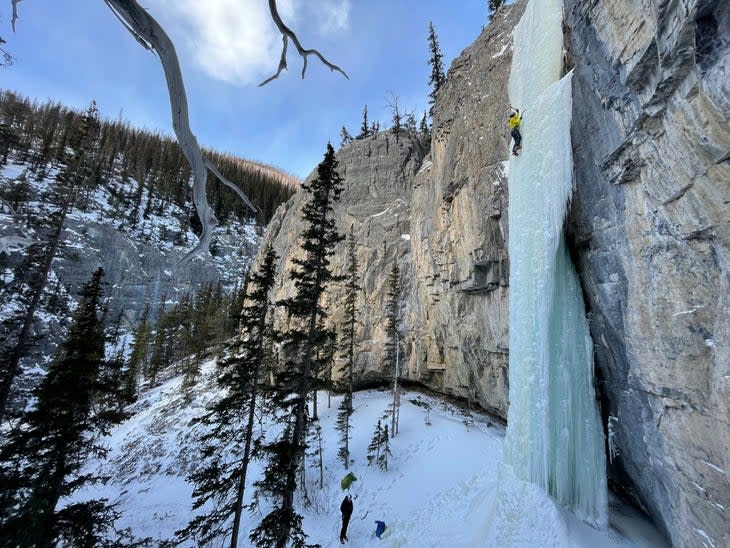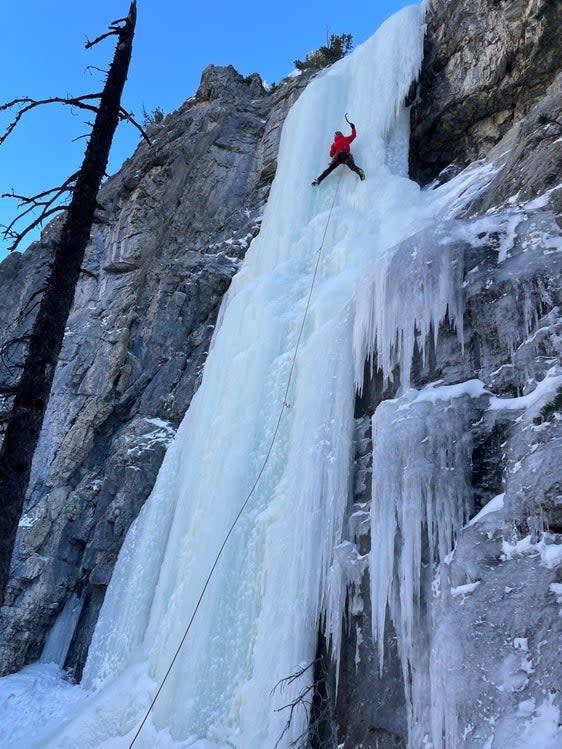Why Climbing Is Worth the Risk for Will Gadd
This article originally appeared on Climbing
“It’s another day above ground, it’s a good day,” said pro ice climber Will Gadd, taking a sip of his coffee and switching lanes in the dark. It wasn’t just his words that struck me--seemingly so out of the blue--but the way he said them. He spoke honestly, free of cliche, and I could feel the gratitude in his voice. It was just after 6 a.m., and Gadd, his friend Rob "Griz" Ginieczki, and I were speeding down the highway towards the Ghost River Wilderness, an iconic and remote ice climbing destination in Alberta, Canada.
Gadd and I had first connected last year when I wrote about the unique risks of leading ice, and again last month, a few days before I was to meet him in Canmore, when he sent over the typical guiding paperwork. In addition to a gear list and release of liability, there was a third document titled “To my Dear Mountain Guests.” In it, Gadd expounded on the inherent risk of going into the mountains; a risk he cannot remove for his guests.
“I mean this,” he wrote in the document. “I really can’t keep us--you or me--completely safe.”
Gadd highlighted specific instances when his guided clients and friends had been injured or died around him. He highlighted that while expertly trained, and with only the best intentions, he is still human and the alpine environment is “infinitely complex.” This document struck me as bold, as a part-time climbing guide myself and someone who has been guided a few times over the years, for it would likely alarm some climbers.

Yes, the alpine environment is infinitely complex, but Gadd justifies climbing there by guiding with an abundance of caution. Our approach in the Ghost, for example, was mostly a trail of flat ice, but with brief vertical sections that Gadd chose to short rope me for. Gadd emphasized engaging as many of the crampon's under-foot points as possible: “People often underestimate low angle ice,” he said, noting that slips can gain momentum quickly and lead to serious injury. For our first ice climb, Yellow Bird (WI 4), he built a tree belay well to the side of any falling ice. I hesitated for an instant before reaching for my belay device, forgetting if it was my turn to belay, and Gadd swiftly changed out our anchor for an even further back tree. He'd interpreted my hesitation as a safety concern--not a side effect of the impracticality of winter gloves and carabiners--and had consequently demonstrated that if he could make something more safe, it was worth the extra effort.
Gadd has witnessed several dark days. When he was around ten, he went ski touring on the Stanley Glacier in the Canadian Rockies with his dad and his dad’s friend. Gadd’s party was skiing a lower-elevation patch of trees when he saw another group ski past them, higher up in the alpine. He remembered hearing a boom through the otherwise still, frozen air, and then later seeing a helicopter fly past with a body bag hanging from it. More recently, a man took a fatal ice climbing fall right next to him.
“Everybody who goes out the door in the morning thinks 'Oh, it’s not going to happen to me today. I’ve got this,'” said Gadd. “But cumulatively, I really believe that if you spend enough time in the mountains you’ll get killed there. That’s what’s going to happen. So you try to do your best at surviving as long as you can.”
Gadd let Ginieczki clean Yellow Bird when it was time to move onto our next climb. As Ginieczki started up, Gadd told him to inspect the tree anchor's fixed webbing before removing the backup of Gadd's top-rope sling. Ginieczki seemed surprised, and asked Gadd if he thought there was anything wrong with it.
“I thought it was totally fine,” Gadd replied. “But you’re the one trusting your life to it, so take a look at it.”
There are many people, and guides, who would have simply said “it’s good” in response to Ginieczki’s inquiry, whether to ease anxiety or to expedite the conversation. But Gadd wanted Ginieczki to recognize the risk he was taking-- even one as common as cleaning a route--and make the decision himself.
Over the phone Gadd spoke about the importance of thinking about risk. “If you’re not doing that then either you are totally okay with the hazards and that’s fine--some people are. Or, you’re not thinking about [the risks]. And to me the second state is a problem.”

Gadd has spent plenty of time contemplating risk in his own life. Gadd first started thinking critically about risk in his late teens, when he chose to pursue more technically difficult forms of climbing instead of finding challenge through riskier climbs. This attentiveness to risk at a young age, he believed, stemmed from his childhood. He grew up in the climbing community where family friends died “somewhat regularly.” "[I couldn’t keep] pretending it wasn’t going to happen to me,” he said.
Gadd examined the higher-risk sports in his life to see which were worth it. Paragliding in high-level competitions was not, because he made poor decisions in that environment; he was so focused on winning that he forgot the primary goal was to survive. He also decided to limit his time on large alpine faces, because he believed their objective hazards, fast-changing conditions, and remote settings came with a higher likelihood of death or serious injury.
"Some people need more risk," said Gadd. "This is not an indictment of risk in climbing at all. As long as they are realistic with themselves--[and] their community."
For Gadd, the benefits of ice climbing are worth the risk. He was animated on the drive up to the Ghost, talking excitedly about what we would see there, and explaining that the adventure begins on the drive in, with the potential to get stuck or pop a tire if you are not equipped for off-roading. He smiled his way up The Eagle (WI 5), his movement smooth and effortless. And when I beamed because I got a satisfying stick, he smiled from the ground, seemingly as pleased with my climbing as I was. Gadd was simply stoked: stoked just to be there, stoked to share the Ghost with Ginieczki and I, and stoked to tackle the "problem" of improving my technique.
Going climbing is part of what has allowed Gadd to live his best life; taking visiting climbers out into the mountains where he was raised. And, Gadd notes, there are other risks that climbing combats, which he calls “dull risks,” such as eating poorly and not exercising. Those risks can add up over a lifetime and cause a person’s life to be cut short, just like someone’s life can be cut short in the mountains.
“I think there’s this massive blind spot in our whole culture,” said Gadd. “We’re all going to die. But none of us expect to. ... I don’t have good answers, but I am aware [of death], and maybe a little more comfortable than most with this. Really, on a gut level, that informs what I’m going to do. I’m not going to mow my lawn. I’m going climbing. I’m not living in fear of death. I’ve made my peace with that. But I’m motivated by life, that’s for sure. You better live today.”
Keely Dickes is a freelancer writer based in Glenwood Springs, Colorado.
Also read:
For exclusive access to all of our fitness, gear, adventure, and travel stories, plus discounts on trips, events, and gear, sign up for Outside+ today.


